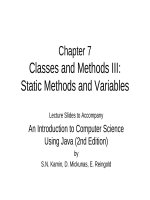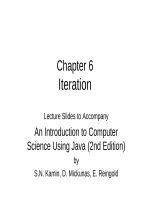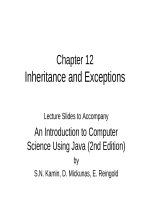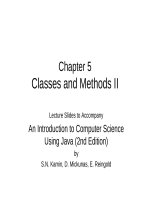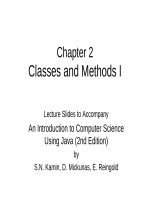Lecture An introduction to collective bargaining and industrial relations (4e) – Chapter 5: Management strategies and structures for collective bargaining
Bạn đang xem bản rút gọn của tài liệu. Xem và tải ngay bản đầy đủ của tài liệu tại đây (398.59 KB, 22 trang )
Chapter
5
Management Strategies and
Structures for Collective
Bargaining
McGrawHill/Irwin
An Introduction to Collective Bargaining & Industrial Relations, 4e
Copyright © 2008 The McGrawHill Companies, Inc. All rights reserved.
1 3
Management's Strategic Choices –
Theoretical Considerations
• Management considers the linkages between
human resource issues and business strategies
If labor becomes organized, management will
attempt to shape the bargaining process within the
context of its bilateral relationship with the union
Management may alter the product mix or operate
nonunion plants
5 3
1 4
5 4
Alternative Industrial Relations Systems
• Nonunion Industrial Relations Patterns
Nonunion industrial relations systems exhibit three
basic patterns
• The common element across the three nonunion
patterns is that management policy is influenced by
a desire to stay nonunion
• Policies are also guided by the firm’s desire to
pursue objectives that have little to do with union
status
• Many firms’ policies contain elements of one of
more of these patterns
1 5
5 5
The Paternalistic Pattern
• Personnel policies tend to be informally administered
and involve substantial discretion by operating
managers
For example, they may not have a formal leave
policy, but grant leaves on a casebycase basis
Mangers would exercise a high degree of discretion
over discipline and pay policies
This pattern is common among small retail stores
and small manufacturing plants
The firms are often familyowned, and do not want
to lose control and union avoidance is a key reason
for paternalism
1 6
5 6
The Bureaucratic Pattern
• Larger firms may find the diversity in personnel
practices of paternalistic firms too unsettling and
costly
They find it necessary to standardize and bureaucratize
policies
They realize that variation of policy can cause
unionization if some employees feel disadvantaged
The bureaucratic pattern is characterized by highly
formalized procedures on policies such as pay, leaves,
promotion, and discipline
It uses detailed job classification and evaluation
1 7
The Human Resource Management
Pattern
The human resource pattern is an outgrowth of efforts to
increase flexibility and cost competitiveness while
maintaining nonunion status
Companies began to adopt this new pattern in the 1970s
Relies on formal policies, but policies that are different
from the bureaucratic pattern
Policies such as team forms of work, skill or knowledge
based pay, elaborate communications and complaint
procedures
Until the late 1980s, firms practiced employment
stabilization; downsizing ended this practice
5 7
1 8
5 8
The Role of Business Strategy in Shaping
Nonunion Patterns
• Many firms in high technology follow the HRM pattern for
flexibility
Steel mills show how practices are linked to strategies
Nonunion minimills producing a variety of products
tend to follow the HRM model, while lowcost and
highvolume mills tend to follow the bureaucratic
pattern
Companies with sophisticated personnel systems are
likely in high growth areas with skilled employees
1 9
5 9
Union Pattern of Industrial Relations
• The New Deal Pattern
Dominated until the 1980s
Characterized by highly detailed and formal contracts
Includes grievance arbitration, senioritybased layoff
procedures, detailed job classifications, and
standardization of pay
The advantage of this pattern is stable labor relations
1 10
5 10
The Conflict Pattern
Labor and management engage in a struggle over basic
rights
Often the dispute is over union representation
Typically involved in long strikes
Imposes high cost through low productivity
Caterpillar Corporation is an example
Major league baseball also followed the conflict
pattern
• A strike or lockout occurred in each of the eight
contract negotiations between the 1970s and 2002
1 11
5 11
The Participatory Pattern
• Characterized by contingent compensation linking
work group pay to economic performance
• Also may include team forms of organization,
employment security programs, and more direct
involvement by workers and unions in business
decision making
Creates mechanisms for workers to directly solve
production and personnel problems
Quality circle or team meetings may be used
Not all firms succeed, due to employee or
supervisory resistance to change
1 12
Management Attitudes Toward
Unionization
• The Historical Evolution of Two Union Avoidance
Strategies
As early as the 1920s, two strategies were used
to avoid unions:
• Direct union suppression (actively resisting
organizing drives)
• Indirect union substitution (removing the
incentives for unions)
In recent years, some firms have instituted peer
review complaint procedures as part of a union
substitution strategy
5 12
1 13
5 13
Increased Union Suppression
• There is evidence that union suppression tactics have
increased in the past 30 years
Employees illegally discharged by employers during
organizing campaigns increased tenfold from 1960 to
1975 and remained high during the 1980s and 1990s
Management’s use of suppressive tactics against union
activists is not merely an artifact of the preNew Deal
labor history, but a significant feature of contemporary
industrial relations
1 14
The Influence of Union Structure on
Management's Unionization Policies
The degree of centralization of bargaining is a
factor in whether a union avoidance strategy will be
used by management
A firm with a single union across the whole
company is less likely to resist unions in newly
opened facilities
• In such cases, the dominant union has the
leverage to engage top management decision
makers at the strategic level of the firm
5 14
1 15
5 15
General Motors Tries and Then Abandons
a Southern Strategy
The GM/UAW relationship is an example of top level
management access and engagement
GM abandoned its strategy of opening nonunion plants
in the south and resisting union organizing attempts
In return for GM neutrality, the UAW agreed to
continue union commitment to quality of working life
and other workplace innovations in the existing union
facilities
The UAW had the strength to induce GM to make this
change
1 16
5 16
The Expansion of Double Breasting
• Where unions lacked the strength to engage top
management, double breasting could take place
• After becoming dissatisfied with the current union,
managements would build new, nonunion plants or
work with different unions in a new plant
In a typical doublebreasted construction company, the
commercial end would be unionized while the
residential side would be nonunion
1 17
The Influence of Attitudes Held by Top
Executives
• The personal views and philosophy of top executives
influences a company’s union avoidance propensities
Although their decisions are based upon costs and
competitiveness, deeply held personal philosophy
may be a powerful influence on corporate behavior
regarding unions
The attitudes of European mangers may be different
from their U.S. counterparts – as work councils,
codetermination, and the extension of employment
laws to eastern Germany seem to demonstrate
5 17
1 18
Overview of Trends in Management
Policies toward Unionization
• In the majority of nonunion or weakly unionized firms,
avoiding unions is a top priority
Highly organized firms tend to be less strongly
opposed to unionization of new plants, provided
their economic and labor relations experience with
their present unions have been relatively favorable
Firms are strongly opposed to organization of white
collar employees, regardless of their experience
with bluecollar workers
5 18
1 19
Management Structures for Collective
Bargaining
5 19
• There are three basic characteristics of management’s
collective bargaining structure:
The size of the labor relations staff (those with
responsibility for handling union organizing attempts,
negotiations, contract administration, and litigation
with unions) in relation to the number of employees in
the organization
The degree of centralization in decision making on
labor relations issues
The degree of specialization in decision making on
labor relations
1 20
5 20
Centralization in Decision Making
• In general, there is a high degree of centralization of
responsibility for labor relations policy inside firms
Most firms place primary responsibility for overall
union policy at the corporate level
In most firms, the corporate labor relations executive
has primary responsibility for developing union
avoidance activities, responding to union organizing
campaigns, conducting contract negotiations, advising
negotiators, and costing contracts
1 21
5 21
Specialization of the Labor Relations
Function
• In recent years, labor relations specialists have
been losing power to line managers and, to a
lesser degree, human resource specialists
Some firms seem to feel that they have less
need for traditional labor relations specialists
and greater need for union avoidance and cost
controls
1 22
5 22
Summary
Historically, management has generally
accepted the value that unions provide to
American society, yet have aggressively
avoided the expansion of unionism
Management remains pragmatic; if the costs
of union avoidance are too high,
management will work with union leaders
Firms either follow paternalistic,
bureaucratic, human resource, conflict, New
Deal, or the participatory industrial relations
pattern


